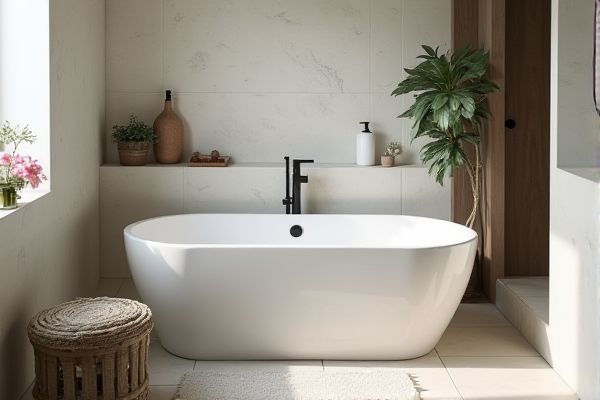
Corner tubs save space and fit seamlessly in smaller bathrooms, while oval tubs provide a classic, spacious bathing experience with elegant curves. Discover the pros and cons of each to determine which tub best suits Your bathroom layout and style preferences in the rest of the article.
Table of Comparison
| Feature | Corner Tub | Oval Tub |
|---|---|---|
| Shape | Triangular or angled to fit corner spaces | Elliptical, smooth and rounded |
| Space Efficiency | Maximizes corner space, ideal for small bathrooms | Requires more wall space, less compact |
| Comfort | Deep soaking, good back support | Ergonomic, offers full body immersion |
| Style | Modern or traditional, fits unique bathroom layouts | Classic and elegant design |
| Installation | Requires corner plumbing and space planning | Standard plumbing, flexible placement |
| Cost | Mid-range, varies with materiais and features | Varies, often higher for premium models |
Introduction to Corner Tub vs. Oval Tub
Corner tubs maximize bathroom space with their triangular design, fitting neatly into corners and providing a unique aesthetic appeal. Oval tubs offer a classic, elongated shape that enhances comfort and style, often accommodating longer soaking experiences. Both tub types prioritize relaxation but cater to different spatial layouts and design preferences.
Design Differences: Corner Tub and Oval Tub
Corner tubs are designed to fit snugly into a 90-degree corner, maximizing bathroom space with a triangular or pentagonal shape that often includes built-in seats or ledges. Oval tubs feature a smooth, elongated, elliptical shape that emphasizes aesthetics and comfort, offering more bathing space and ergonomic contours ideal for soaking. The corner tub's angular design suits compact layouts, while the oval tub provides a classic, spacious feel, often serving as a centerpiece in larger bathroom designs.
Space Efficiency and Bathroom Layout
Corner tubs maximize bathroom space by fitting snugly into corners, making them ideal for smaller bathrooms or layouts with limited square footage. Oval tubs, while often larger and more luxurious, require more floor space and work best in spacious bathroom designs with open floor plans. Your choice depends on how efficiently you need to use space and the overall layout of your bathroom.
Installation Process and Requirements
Corner tubs require precise measurements to fit snugly into angled spaces, often necessitating customized plumbing adjustments and reinforced framing for support. Oval tubs typically demand more straightforward installations due to their standard shape, fitting easily into rectangular alcoves with conventional plumbing setups. Choose your tub based on your bathroom layout and the installation complexity you're prepared to manage.
Comfort and Ergonomics Comparison
Corner tubs offer a unique ergonomic advantage by maximizing space and allowing for a more spacious seating area, ideal for users who prefer reclining or soaking with extended legroom. Oval tubs provide a smooth, rounded shape that contours naturally to the body, enhancing comfort through uniform support and reducing pressure points. Choosing between the two depends on whether Your priority is space-efficient relaxation or a gently enveloping bath experience.
Material Options and Durability
Corner tubs commonly feature acrylic and fiberglass materials, offering lightweight durability and cost-effective maintenance, while oval tubs often utilize cast iron and acrylic, providing enhanced sturdiness and heat retention. Acrylic corner tubs resist chipping and fading but may scratch more easily compared to cast iron oval tubs, which are heavy and highly durable with superior longevity. Selection depends on balancing material benefits like ease of installation and heat retention with durability requirements tailored to bathroom usage.
Cost and Budget Considerations
Corner tubs generally cost less to purchase and install compared to oval tubs due to their compact design and efficient use of space. Oval tubs often require more material and space, leading to higher expenses for both the tub itself and installation, especially in larger bathrooms. Understanding your budget and bathroom layout can help you decide which tub fits your financial plan and aesthetic preferences.
Style and Aesthetic Appeal
Corner tubs maximize bathroom space with their angular design, creating a modern and geometric aesthetic that complements small or uniquely shaped rooms. Oval tubs offer a classic, smooth silhouette that brings elegance and softness to any bathroom decor, enhancing a spa-like atmosphere. Your choice between these styles depends on whether you prioritize space efficiency or timeless curves to elevate your bathroom's visual appeal.
Maintenance and Cleaning Ease
Corner tubs typically have more angles and crevices, making maintenance and cleaning slightly more challenging compared to oval tubs. Oval tubs feature smooth, continuous surfaces that facilitate easier wiping and vacuuming, reducing the buildup of soap scum and mildew. Choosing an oval tub can lead to more efficient cleaning routines and lower maintenance efforts over time.
Which Tub is Best for Your Bathroom?
Choosing between a corner tub and an oval tub depends on your bathroom layout and personal preferences. Corner tubs maximize space, fitting neatly into room corners and often featuring built-in seating or jets for added comfort. Oval tubs offer a sleek, timeless design with ample soaking space, ideal for larger bathrooms seeking a focal point with smooth, elegant curves.
 homyna.com
homyna.com